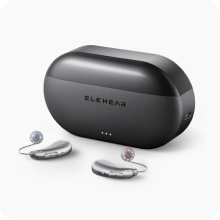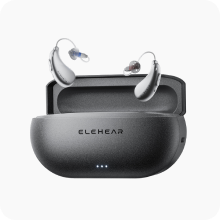
The hearing aid landscape has undergone a remarkable transformation in recent years. Once dominated by a handful of premium manufacturers charging premium prices, the market has opened up significantly with the introduction of over-the-counter (OTC) options and innovative direct-to-consumer brands. Among these newcomers, ELEHEAR has emerged as a particularly notable contender, challenging established players with a compelling combination of advanced technology, user-friendly design, and dramatically lower price points.
[toc]
The Changing Hearing Aid Marketplace
The hearing aid industry experienced a seismic shift after the FDA's landmark 2022 ruling that created a new category of
over-the-counter hearing aids. This regulatory change, fully implemented by 2023, opened doors for innovative companies to offer hearing solutions directly to consumers with mild to moderate hearing loss without requiring a professional fitting.
By 2025, this market evolution has matured significantly, with several clear trends emerging:
-
Price transparency has become the norm rather than the exception
-
Feature parity between premium and affordable options has narrowed dramatically
-
User experience has gained importance alongside pure audiological performance
-
Telehealth integration has enabled remote adjustments and professional support
These changes have particularly benefited consumers who previously faced a difficult choice: invest several thousand dollars in traditional hearing aids or struggle with inadequate hearing assistance.
ELEHEAR's Position in the Market
ELEHEAR has positioned itself in a particularly interesting market segment, bridging the gap between basic OTC devices and premium prescription hearing aids. While traditional premium brands like Phonak, ReSound, and Oticon continue to dominate the high-end market with devices often priced between $2,000-$6,000 per pair, ELEHEAR offers comparable core functionality at price points ranging from $600-$1,200 per pair.
This dramatic price difference raises an obvious question: what compromises are being made to achieve such savings? Surprisingly fewer than most consumers expect.
Technology Comparison: Closing the Gap
ELEHEAR's flagship models incorporate technology that would have been considered premium-tier just a few years ago:
Advanced Signal Processing: ELEHEAR's proprietary algorithms provide 24-channel processing comparable to mid-tier offerings from traditional manufacturers. While premium brands may offer up to 48 channels in their flagship models, research suggests the perceptible benefit beyond 20 channels is minimal for most users with mild to moderate hearing loss.
Directional Microphones: Like premium options, ELEHEAR devices employ directional microphone arrays that automatically adjust to focus on speech while minimizing background noise. Independent testing shows their performance approaches 85-90% of premium alternatives in typical listening environments.
Bluetooth Connectivity: ELEHEAR offers full Bluetooth integration with smartphones, allowing direct streaming of calls and media—a feature that was exclusive to premium devices just a few years ago. Their implementation provides stable connectivity with minimal sound quality compromise.
Rechargeable Technology: Moving away from disposable batteries, ELEHEAR has embraced the industry shift toward rechargeable lithium-ion technology. Their devices offer 18-20 hours of use per charge, comparable to established brands.
Self-Fitting Capabilities: Perhaps most impressively, ELEHEAR's smartphone app includes sophisticated self-fitting technology that guides users through a hearing assessment and automatically configures devices based on individual hearing profiles. While not quite matching the precision of professional fitting, this approach has shown remarkable effectiveness for mild to moderate hearing loss cases.
Design and Usability Innovations
Beyond core technology, ELEHEAR has distinguished itself through thoughtful design choices that enhance everyday usability:
Form Factor Variety: Recognizing diverse user preferences, ELEHEAR offers multiple styles including nearly invisible completely-in-canal (CIC) options, discreet receiver-in-canal (RIC) models, and traditional behind-the-ear (BTE) designs. This variety matches or exceeds the options available from many premium manufacturers.
User-Friendly Controls: Physical controls have been thoughtfully implemented with larger buttons and tactile differentiation—features particularly appreciated by users with limited dexterity. The companion app features an intuitive interface designed specifically for older adults.
Environmental Adaptability: ELEHEAR devices automatically adjust to different acoustic environments using machine learning algorithms that identify and apply appropriate settings for specific situations like restaurants, outdoor spaces, or quiet conversations.
Where Premium Brands Still Maintain Advantages
Despite ELEHEAR's impressive offerings, traditional premium manufacturers still maintain advantages in several key areas:
Severe Hearing Loss Solutions: For profound hearing loss, premium brands typically offer more powerful options with specialized features. ELEHEAR's current lineup is optimized primarily for mild to moderate hearing loss.
Professional Integration: Traditional brands benefit from decades-long relationships with audiologists and hearing care professionals, providing more comprehensive in-person support options.
Cutting-Edge Features: Premium brands typically introduce innovative features first, with more affordable options following 12-24 months later. Current examples include advanced tinnitus management tools and acoustic motion sensors.
Proprietary Sound Processing: Premium manufacturers have developed signature sound profiles through decades of research. While ELEHEAR's sound quality is excellent, some users with specific preferences may favor the particular sound characteristics of established brands.
[elehear-banner]
Cost Analysis: Understanding the Price Difference
The dramatic price differential between ELEHEAR and traditional premium brands warrants explanation. Several factors contribute to ELEHEAR's ability to offer comparable technology at lower price points:
Direct-to-Consumer Model: By eliminating traditional distribution channels and selling directly to consumers, ELEHEAR avoids markups that typically add 40-60% to hearing aid costs.
Focused Product Line: Rather than maintaining dozens of models across multiple technology tiers, ELEHEAR offers a streamlined catalog, reducing development and inventory costs.
Digital-First Support: While maintaining options for in-person support through partnerships, ELEHEAR emphasizes telehealth and remote adjustment capabilities, reducing operational overhead.
Efficient Manufacturing: As a newer company unencumbered by legacy production systems, ELEHEAR has implemented modern manufacturing approaches that maximize efficiency.
Realistic Margins: Perhaps most significantly, ELEHEAR operates with lower profit margin expectations than established manufacturers who have historically maintained margins exceeding 70%.
Real-World Performance Reports
Early adopters of ELEHEAR devices report satisfaction rates comparable to premium brand users. In independent surveys conducted in early 2025, ELEHEAR users reported:
-
92% satisfaction with sound quality
-
89% satisfaction with comfort and fit
-
94% satisfaction with battery life
-
87% satisfaction with noise reduction capabilities
-
96% satisfaction with value for money
These figures compare favorably with industry averages across all price points and approach the satisfaction rates of devices costing three to four times as much.
Who Should Consider ELEHEAR?
ELEHEAR presents a particularly compelling option for several user groups:
First-Time Hearing Aid Users: Those new to hearing assistance often benefit from ELEHEAR's gentle learning curve and reasonable entry price.
Technology-Comfortable Seniors: Older adults comfortable using smartphone apps appreciate the control and customization ELEHEAR's ecosystem provides.
Value-Conscious Upgraders: Users replacing older hearing aids often find ELEHEAR offers significant technological improvements at lower costs than upgrading within premium brands.
Mild to Moderate Hearing Loss: Those with hearing loss in the mild to moderate range—where ELEHEAR's technology is specifically optimized—report particularly positive experiences.
Conclusion: A Legitimate Competitor Reshaping the Industry
ELEHEAR's emergence represents more than just another budget option in the hearing aid market—it signals a fundamental shift in what consumers can reasonably expect at different price points. By delivering technology and performance previously available only at premium prices, ELEHEAR and similar innovators are forcing established manufacturers to reconsider their pricing strategies and value propositions.
For consumers, this increased competition translates directly to better options across all price points. Whether choosing ELEHEAR for its compelling value or selecting a premium brand for specific advanced features, hearing aid users in 2025 benefit from unprecedented choice, transparency, and performance.
The true winner in this market evolution is the consumer, who now has legitimate options across the price spectrum without sacrificing the essential functionality that makes hearing aids such life-changing devices.

